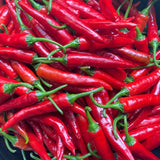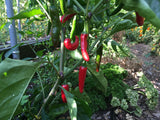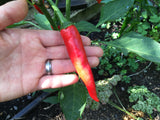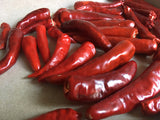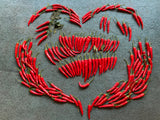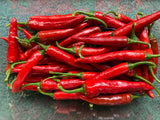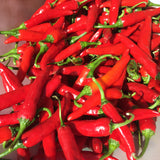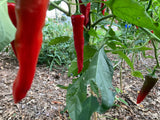Korean Hong-Gochu Pepper
Capsicum annuum
Bright red fruits with thin skins are perfect for kimchi and drying down for gochugaru (chili flakes) and gochujang (fermented chili paste). This mild to medium pepper starts out green and turns red ("hong"), and then an even deeper red after drying.
This seed was grown for our catalog by Jungeun Kim (J.e.) who hails from Seoul, South Korea. As part of her studies with the Seed Keeping Fellowship at Greensgrow Farms in Philadelphia, she tended to some of her favorite Korean heritage crops from seed to seed. Here’s what she has to say about this pepper:
"Gochu is a Korean name for a hot pepper or chili pepper. When I think about Gochu, the first thing I think about is the image of numerous Gochu laying on a mat on a sunny day. It's very nostalgic and I feel like I can still smell them. I grew up seeing the drying Gochu in many residents' back/front yard and rooftop including my own home. I don't recall seeing a Gochu plant in the garden growing up at my house but we did dry Gochu in the backyard. As a side note, rooftop gardens are very popular in Seoul since many residents don't have a yard or don't get enough sunlight. There are stores in South Korea where people can bring their dried Gochu and they will grind them for you which becomes Gochugaru (hot pepper powder/flakes).
"When I harvested Gochu at Greensgrow last summer, I brought a bunch home and dried them so that I could grind them to make Gochugaru. I just laid them out in the front of our house (indoor) which faces South and I get a good amount of sunlight. So if you end up having too many Gochu and are unsure of what to do with them, try drying them and making your own Gochugaru. The finer you can get is better for sauce or broth and the coarse one is better for Kimchi. I have never done this but if you want to make Gochujang (hot pepper paste), it's recommended to use fine Gochugaru."
J.e. sourced these seeds originally from our friends at Adaptive Seeds, who sourced theirs from Sample Seed Shop, who received them directly from a lady in Korea. Adaptive Seeds has spent several years selecting this plant to thrive in Oregon, and now it is beginning its adaptation to Philadelphia with J.e.’s care.
Days to maturity: 75 to green, 90 to red
Seeds per pack: 20
Germination rate: 92% on 10/10/2024
Planting / harvesting notes
Start seeds indoors 8-10 weeks before the last frost and transplant into garden well after the danger of frost. Keep seedlings moist but do not overwater. Transplants should be initially watered in well, and plants will be most productive with regular irrigation and full sun.
Seed keeping notes
Peppers are generally self-pollinating, though we isolate different varieties of the same species by at least 50 feet, in hopes that flying insects will not cross pollinate them unexpectedly. There are several important species of peppers, so check your scientific names! Pepper seeds are ripe when the fruits have turned their final fiery color - in this case, fully red. Cut the fruit, scrape out seeds, and lay them out to dry on a labeled screen or paper product in a ventilated place away from direct sunlight for a week or two. Drying the peppers before seed extraction can slightly lower your germination rates, but works fine for home seed saving as long as the peppers do not rot.









